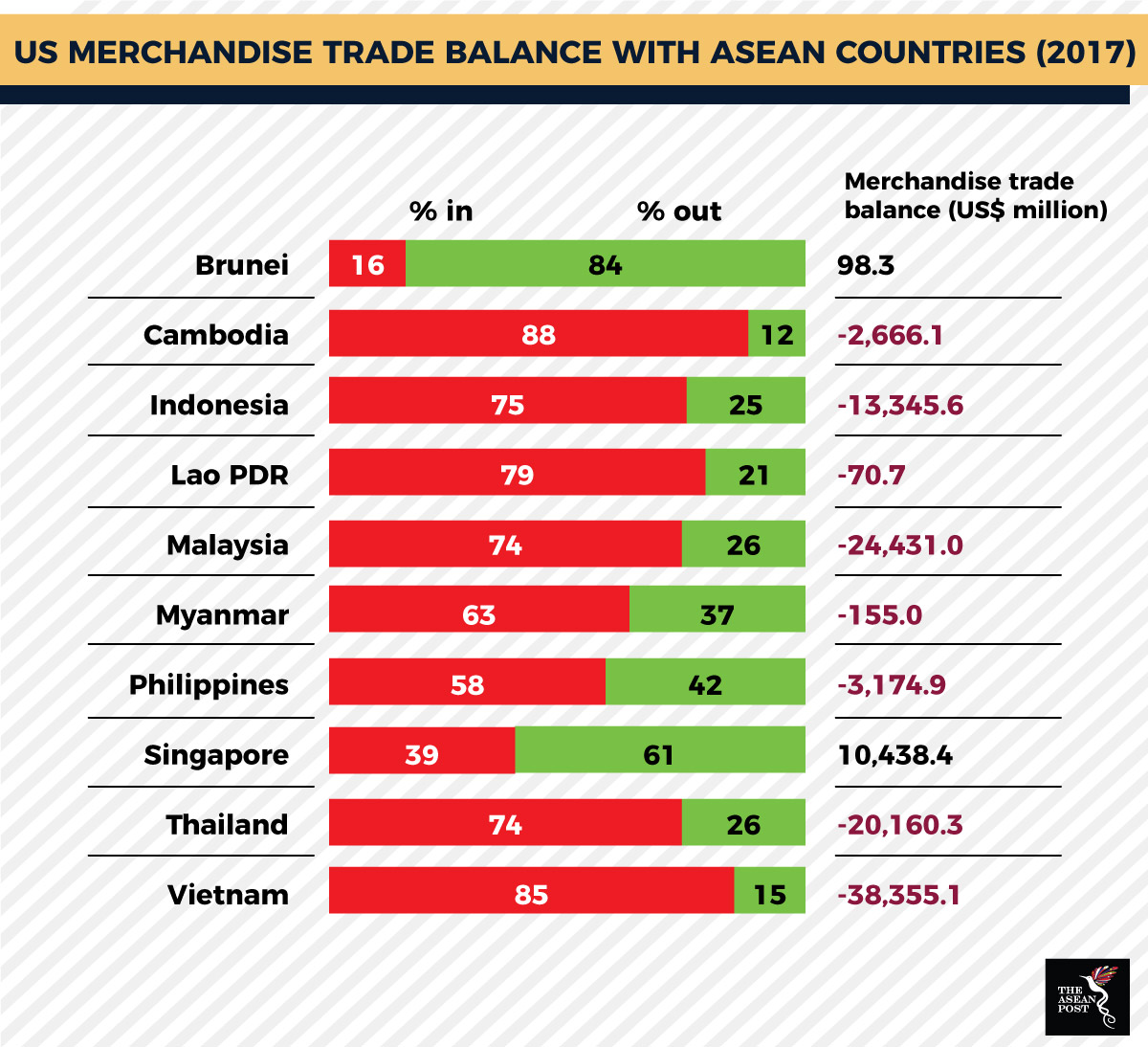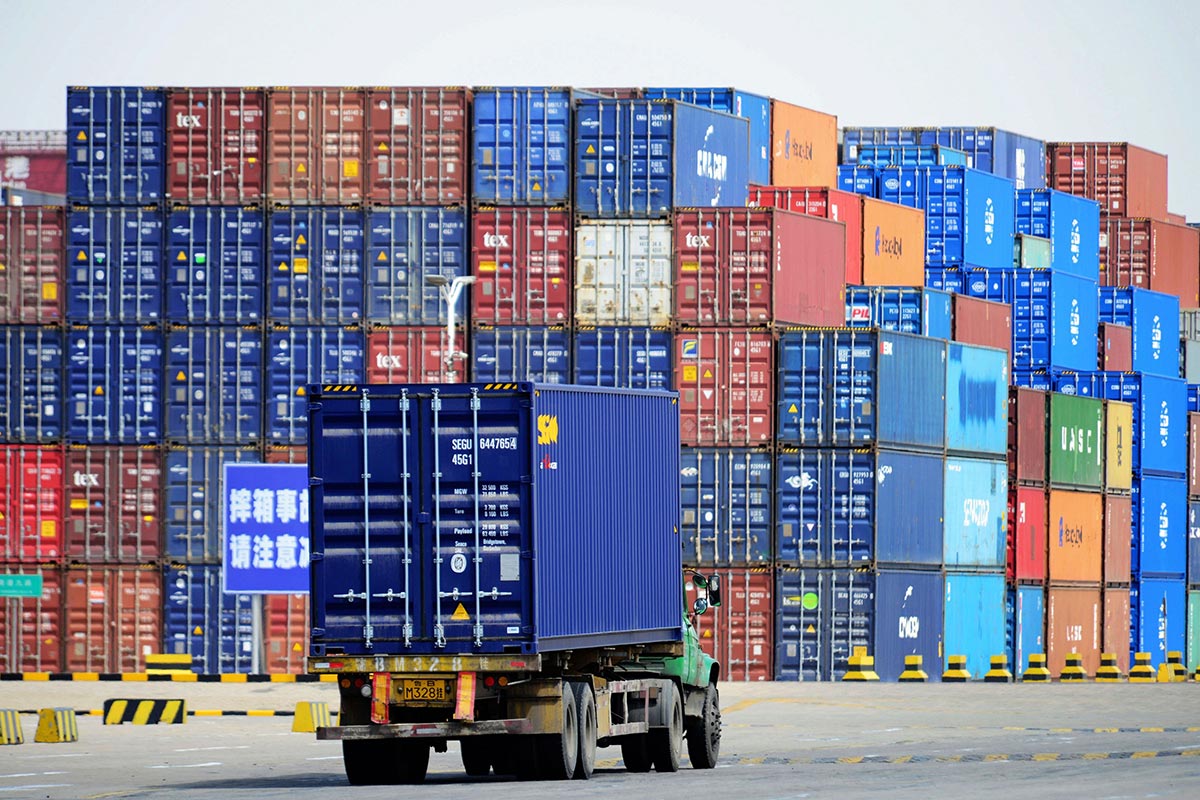The United States (US) is not stopping with China; it has threatened or engaged in trade wars with Canada, Mexico and the European Union (EU). Could ASEAN member states also be on US President Donald Trump’s list of targets?
The US has a combined trade deficit of US$91.8 billion with ASEAN nations, with the largest three being Vietnam, Malaysia and Thailand as of 2017.
Vietnam imported US$8.1 billion and exported US$46.5 billion worth of goods to the US, with a trade deficit of US$34.4 billion. The country ranks sixth on the US Trade Representative Office’s list of trade deficits in 2016.
The rest of the billion-dollar-deficit club in ASEAN include Malaysia (US$24.4 billion), Thailand (US$20.2 billion), Indonesia (US$13.3 billion), the Philippines (US$3.2 billion) and Cambodia (US$2.7 billion). Thailand sits in 11th place on the US’ trade deficit list.
At the other end of the spectrum are Singapore and Brunei with whom the US has a trade surplus of US$10.4 billion and US$98.3 million, respectively.
In March, Jeffrey T. Gerrish, deputy US Trade Representative for Asia, Europe, the Middle East and Industrial Competitiveness sounded a warning.
“The United States does a lot for ASEAN in terms of market access. We need ASEAN to do more for us,” he said at the US-ASEAN Business Council’s annual gala dinner in Washington.
“Whether they relate to agricultural imports in Thailand or vehicle barriers in Vietnam, localisation requirements in Indonesia, or emerging barriers to electronic payment services in several countries, we will work with our ASEAN partners to address and resolve these issues successfully and to our mutual benefit,” he said.
 Source: United States International Trade Commission
Source: United States International Trade Commission
Vietnam
Bilateral trade relations between the US and Vietnam resumed in 1994 when then-US President Bill Clinton lifted a 30-year embargo. Both countries signed their first bilateral trade agreement (BTA) in 2000 which conferred Vietnam a “conditional most favoured nation (MFN)" status.
Vietnam was upgraded to permanent normal trade relations (PNTR) status in 2006 as part of its ascension to the World Trade Organisation (WTO). US exports to Vietnam steadily increased over the next decade from US$1.1 billion to US$8.1 billion in 2017.
The US is Vietnam’s second largest trading partner behind China. The bulk of its exports to the US are textiles and garments, footwear, telephones, mobile phones and parts.
Vietnam also exports telephones, mobiles phones and parts, intermediate electrical components and well as fruits and vegetables to China. If China manufacturers reduce their demand for components, it will impact a number of countries in its global supply chain, including Vietnam, Malaysia and Singapore.
Vietnam’s steel industry is already a target of Trump’s trade war. The US accused China of circumventing tariffs imposed on Chinese steel in 2015 and 2016 and in May, imposed heavy tariffs on Vietnam for steel products that originated from China.
Chinese companies may respond to the US-China trade war by relocating their manufacturing to Vietnam. Despite the economic benefits, there is concern that a flood of cheap Chinese products may impact local industries.
Malaysia
US tariffs on solar panels, washing machines, steel and aluminium will not impact Malaysia drastically as these represented just 0.8 percent of the country’s total exports in 2017, and 10.6 percent of its exports are exposed to the US. Nonetheless, the US imports 25 percent of solar panels from Malaysia.
China is one of Malaysia’s top trading partners for electrical and electronic product components. Exports are likely to suffer but this can be mitigated if Chinese companies relocate their factories elsewhere in the region and resume production.
The trade war also brings opportunities to Malaysia which sells chemical products to the US and may profit when China’s exports are curbed. Soybean tariffs imposed by China in retaliation are expected to boost sales of alternative vegetable oils, such as palm oil.
Thailand
Thailand’s exports are mostly primary. Like Vietnam and Malaysia, it enjoys over US$20 billion in trade surplus and is at risk of attracting the attention of the US Trade Representative Office.
China’s retaliatory tariffs on US agricultural products may give a boost to Thailand’s fresh and processed fruits export.
Thailand’s automotive industry may also benefit from the global trade tensions. Trump incurred the EU’s ire when he tweeted a threat to slap on a 20 percent import tariff on Europe-made cars. It threatened to respond with tariffs on US$300 billion of US goods.
Motorcycle manufacturer Harley-Davidson is not waiting to see the outcome. It is closing its factory in Kansas City and moving some of the work to Thailand.
Indonesia
Indonesia exports mostly manufactured articles, food and live animals to the US. It exports mineral fuels, animal and vegetable oils and base metals and articles to China.
The republic is undergoing a construction boom and does not export significant amounts of aluminium, iron or steel. This insulates Indonesia from US tariffs. It may even benefit from cheaper steel, aluminium and iron if China decides to push its excess supply into Indonesia.
However, a reduced demand from China for base metals and articles will likely affect exports.
Like Malaysia, Indonesia’s palm oil industry may benefit as an alternative to pricier soybeans.
Philippines
The Philippines may suffer in terms of exports for intermediate electronic products. The country may benefit, however, from increased demand for its pork exports and cheaper steel prices. It enjoys a trade surplus of US$3.2 billion with the US.
Cambodia
The US is Cambodia’s top trading partner and a majority of its exports are textile-related, clothing products and footwear. This is currently not on either US nor China’s radar. The US’ trade deficit with Cambodia is also small, at US$2.7 billion.
Myanmar
Myanmar is in the midst of finalising an agreement to export cattle to China. The quantity of exports will likely rise as China’s tariffs on US agricultural products will make US beef more expensive. Chinese companies may also establish factories in Myanmar’s Thilawa Special Economic Zone (SEZ) to capitalise on low labour costs and circumvent US tariffs on China.
Myanmar was named eligible for preferences under the US General System of Preference program in 2016 and bilateral trade in 2017 reached US$577.8 million. Myanmar enjoys a US$155 million trade surplus and should be safe from Trump’s scrutiny.
Lao PDR
A large proportion of Lao PDR’s exports are machinery, transport equipment and manufactured products, including intermediate goods. It’s main trading partners are Thailand (42.6 percent), China (28.6 percent) and Vietnam (10.4 percent). Two-way trade with the US totalled US$122.1 million in 2017 and the US only has a US$70.7 million trade deficit with Lao PDR.
